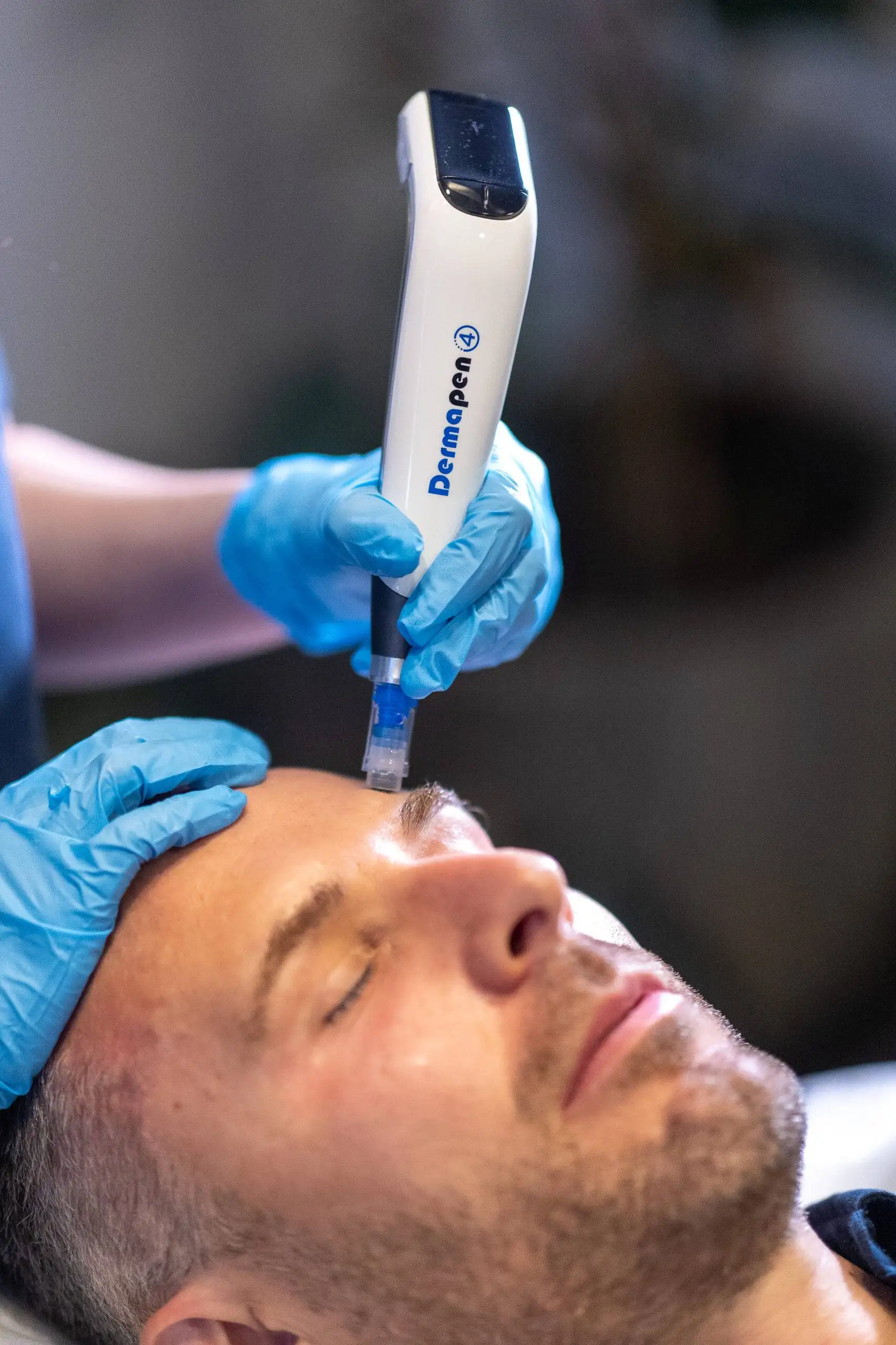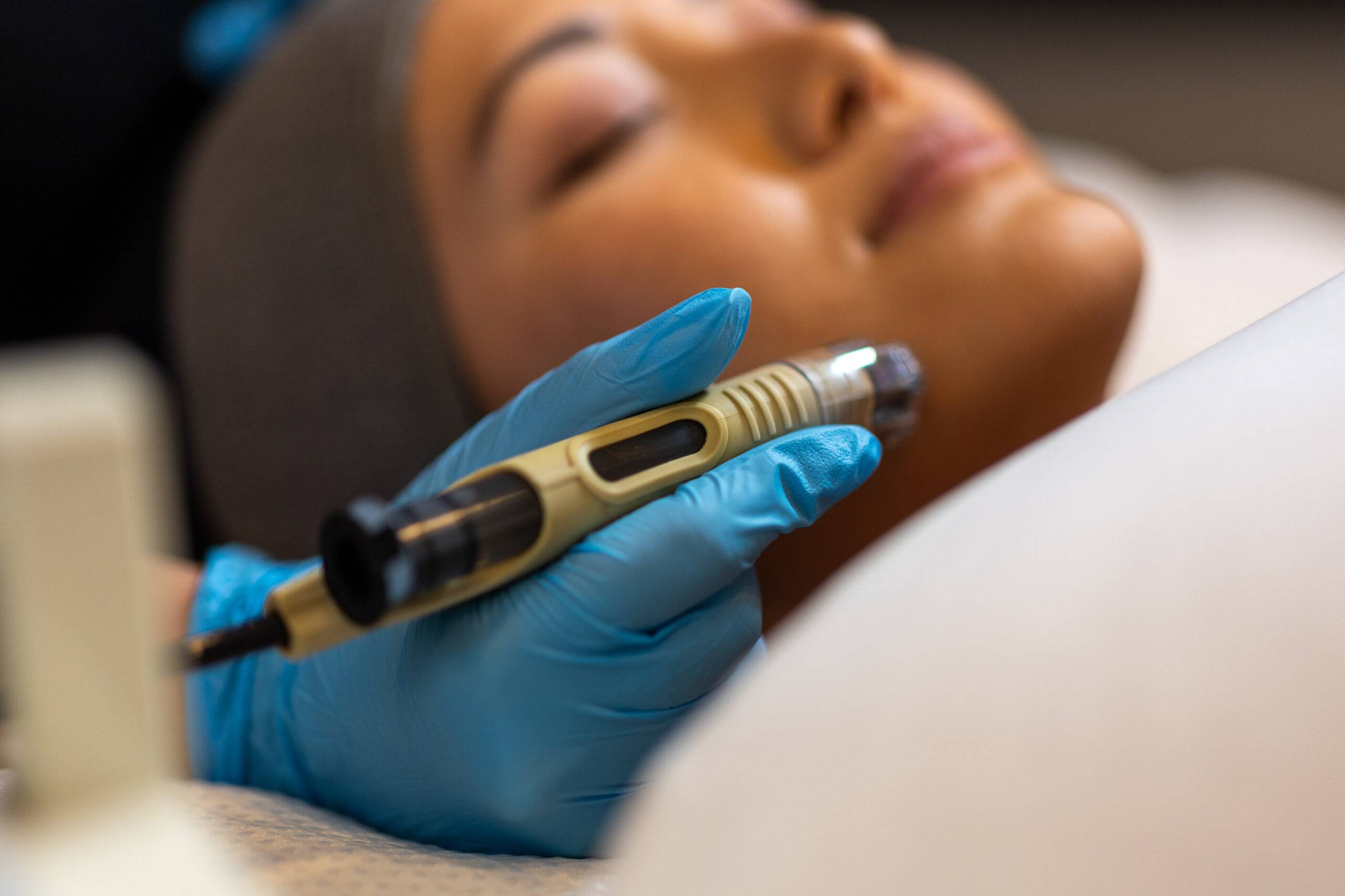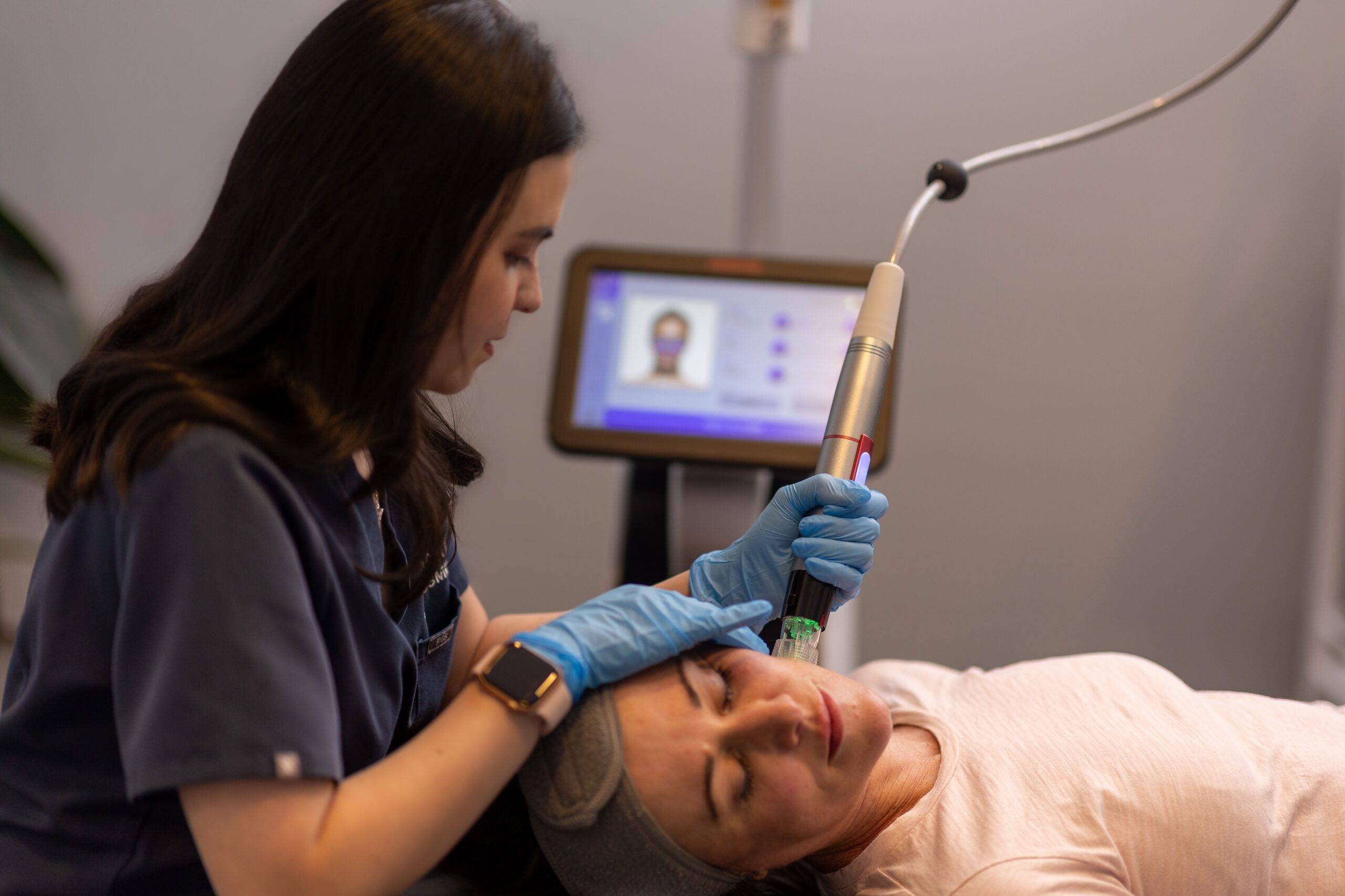Microneedling

Microneedling is a highly effective and minimally invasive skin treatment used to rejuvenate the skin and address various skin concerns. At Kaya Cosmedica technologies such as Dermapen 4 , Dermafrac, and Genius RF are utilised to stimulate collagen production, resulting in improvements in skin texture, fine lines and wrinkles, scars, pigmentation irregularities and skin tightening.
TIME
15-30 minutes
DISCOMFORT
![]()
![]()
![]()
![]()
![]()
DOWNTIME
LONGEVITY
Average 3-4 months
SUITABLE FOR
Collagen remodelling, Fine Lines & Wrinkles, Skin Laxity, Scarring, Pigmentation
PREGNANCY SAFE?
What Is Microneedling?
This cosmetic treatment uses a device that administers multiple fine needles into the dermal structure at one time to create micro-injuries to initiate the body’s healing response. The depth of the treatment can be adjusted to produce the precise amount of regenerative response necessary to achieve the exact amount of skin rejuvenation you desire.
Microneedling is often referred to as collagen induction as microneedling also initiates collagen production. Collagen is a protein that supports the underlying dermal structure to produce skin that is soft and smooth. As we age, our bodies produce less collagen which leads to skin laxity and the formation of fine lines and wrinkles.

Clinical Uses for Microneedling
Microneedling is an effective procedure for addressing a wide range of skin concerns, including:
- Fine lines and facial wrinkles
- Shallow scarring from acne or other causes
- Pigmentation irregularities, including brown spots and freckles
- Open, enlarged pores
- Skin that is dry, dehydrated or sun damaged
Dr Khinda and the team at Kaya Cosmedica will provide a personalised assessment of your skin to determine whether microneedling is the right treatment to help you reach your aesthetic goals. Unlike laser treatments, this procedure works for all skin types and tones, including darker skin colours.
What Does the Procedure Involve at Kaya Cosmedica
Dermapen 4
Dermapen 4 is a pen-like device with adjustable needle depth, speed and treatment settings. The needles create micro channels in the epidermis (outer layer of skin) and dermis (the layer underneath the epidermis), triggering elastin and collagen production and increasing cell turnover. Dermapen 4 microneedling can address a variety of facial skin concerns — even in delicate areas like around the eyes and lips — as well as body blemishes like scars and stretch marks.
Dermapen 4 begins with cleansing and sterilising your skin. Once your skin is prepped , the device settings will be adjusted to the appropriate levels for your concerns and goals. The Dermapen 4 glides over the skin— and can be used in a gentle stamping motion for increased precision and maximum patient comfort. The handpiece’s unique design also reduces cross-contamination and fluid backflow, making Dermapen 4 treatments safer and more hygienic than other options.
Although every patient’s experience is different, most people find the sensations of a microneedling procedure tolerable. There is no need to apply a skin numbing agent prior to a Dermapen 4 treatment. Immediately after the procedure, your skin may look red and feel warm and tight. There may be 2-3 days of downtime however any post-treatment effects you experience will likely subside within a day.
Dermafrac
Dermafrac is a customisable advanced treatment that combines microdermabrasion and microneedling while simultaneously infusing serums for comprehensive rejuvenation. The first step involves a consultation to personalise a treatment protocol that is suitable for your skin condition and concerns. We will recommend the best serum for you based on this evaluation. Once your unique needs are understood, your skin will be cleansed and primed.
Microdermabrasion is performed first to remove the outermost skin cells and debris from the skin to create a clean, fresh palette for the microneedling to follow. Microdermabrasion also promotes healthy circulation underneath the skin’s surface to increase the health and vitality of your skin once your microneedling process is completed.
The treatment is then followed by microneedling and infusion. Dermafrac micro needling involves the use of a vacuum device that contains 180 microneedles The needles enter the skin at the precise depth necessary for the amount of correction desired, while the serum travels simultaneously into the deeper dermal layers.
Serum infusion options:
Rejuvenate: a ‘super cocktail’ of peptides to assist in skin rejuvenation.
Hydrate: Hyaluronic acid triggers intense hydration. A patented formulation using HylaSponge® technology may result in sustained hydration of the skin.
Clarify: Lactic and salicylic acids help cleanse congested, oily pores for more vibrant, clearer skin.
Lighten: Kojic acid is a natural and effective lightening agent shown to even out pigment.
Vitamin C: Vitamin C Ethyl Ascorbic Acid is an antioxidant that slows the rate of oxidation damage & minimizes the appearance of fine lines & wrinkles.
Radio Frequency Microneedling
The Genius RF system includes a handheld device that produces RF energy through insulated gold-plated microneedles. Your practitioner here at Kaya Cosmedica will select a treatment tip and adjust the device settings to suit the unique needs of your skin. Once the system is calibrated, your practitioner will move the handpiece over your skin in a stamping motion, pausing long enough to allow the needles to transmit RF energy into the dermal layer. Depending on the area being targeted, your practitioner may make more than one pass. Many areas of the body are treatable, including the face, neck, décolletage, underarms, abdomen, arms and thighs.

Frequently asked questions
Results from microneedling appear gradually as the body’s processes go to work stimulating cell renewal and collagen production. However, you will likely see some preliminary improvement as soon as your treatment is over which will continue. To produce the most significant outcome we recommend a minimum of three treatments for best results. Our team will work with you to develop a personalised treatment plan tailored to your specific concerns and goals. Once full results are achieved, an occasional touch-up treatment will help you maintain your radiant glow over the long term.
Microneedling is an efficient way to rejuvenate the complexion with fewer risks than laser devices. This procedure is quick and relatively painless while offering dramatic, long-lasting results. To learn more about microneedling in Melbourne with Dermapen 4, Dermafrac or Radiofrequency contact Kaya Cosmedica today on 03 9329 9991.
Dermafrac: Dermafrac generally has minimal downtime to none. You can return to your normal activities and even reapply your makeup immediately following the treatment. You may experience some pink or slightly red areas, which should fade within a few hours.
Dermapen 4 :Immediately after the treatment your skin will be quite warm, tight and red. These side effects are normal and will subside within 2-5 days
Radiofrequency Microneedling: After your RF microneedling session, your skin will be red and may feel warm and inflamed. You may look as if you have a sunburn. These initial effects typically subside within a few days following treatment. Scattered pinpoint bleeding, mild bruising and temporary marks from the needles are also possible. As the micro-injuries heal, you may notice tiny crusts forming in the treated area. Allow these to fall off on their own. You should not rub or pick at them, as this can lead to irritation, infection or scarring. There is minimal downtime following RF microneedling, and most activities can be resumed straight away. However, some people choose to take a day or two off social activities to allow the post-treatment redness to fade.
At Kaya Cosmedica, we prioritise your safety and comfort. When used correctly and performed by an experienced practitioner, the risks and side effects are minimal. It is normal to experience redness following the treatment. Microneedling at Kaya’s South Melbourne clinic is safe and effective and is an efficient method to address multiple concerns. To find out if you are suitable for the treatment, contact Kaya Cosmedica today at 03 9329 9991 to schedule your one-on-one consultation, or use our simple online booking form to make your appointment!
Immediately following your treatment:
- For the first 12 hours following treatment, avoid heat or sweating, and exercise.
- For the first 48 hours, avoid sun exposure, saunas, spas or chlorinated pools.
- Limit stimulants like coffee and alcohol where possible, and avoid hot showers or friction to the face such as abrasive towels.
For the next 7 days post treatment:
- Full sunscreen protection is recommended with a broad spectrum SPF 50, sun avoidance, hat and sunglasses.
- Cleanse the skin with a general cleanser
- Avoid actives (hydroxy acids, retinoids, Vitamin C)
- Once all signs of inflammation have subsided (typically 5 – 7 days post treatment) resume a normal skincare regime.
- Flaking may occur at 3-5 days – do not pick, scratch or abrade the skin in the treated area. This will impact your results.
- Avoid facial waxing and shaving
As needling continues to gain popularity as a skin care essential, a number of at-home devices have been introduced as alternatives to in-office microneedling treatments. While both work similarly, at-home needling devices cannot achieve the same results as professional microneedling. Microneedling devices that can be purchased for personal use contain shorter needles that cannot reach the layer of skin that’s most helpful in growing fresh collagen. Skin needling at home also increases the risks of over-treatment or infection from improperly cleaned tools.
By choosing a professional microneedling treatment at Kaya Cosmedica, you can guarantee that high-quality devices are used and the highest standards of hygiene and safety are met. Overall, microneedling done by an experienced practitioner is a safer and more effective treatment.
The team at Kaya Cosmedica will spend ample time understanding your concerns and goals so your Dermafrac treatment can be tailored precisely to the needs of your unique skin. With a thorough understanding of skin health and microneedling techniques, the team can help you turn problem skin around and enjoy a younger-looking, more luminous complexion.
At Kaya Cosmedica, we prioritise your safety and comfort. When used correctly and performed by an experienced practitioner, the risks and side effects are minimal. It is normal to experience redness following the treatment.
BOOK A CONSULTATION
Book Your Microneedling Consultation Today
Microneedling at Kaya’s South Melbourne clinic is safe, effective, and efficient for addressing multiple concerns. To find out if you are suitable for the treatment, contact Kaya Cosmedica today at 03 9329 9991 to schedule your one-on-one consultation, or use our simple online booking form to make your appointment!
